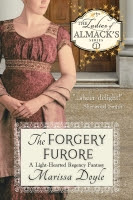The overall condition of the
page and samples is excellent, considering it is over two hundred years old. I
operate under the assumption that the now-cream-colored paper samples were once
much whiter but have yellowed due to the acid content of their material, just
as the pages of Ackermann’s Repository
themselves have done.
In the annexed print, No. 1, is a newly manufactured white cartridge
paper, of very superior quality. Those of our readers who have practiced
painting in water colours, know that the two great faults of drawing papers
are, either that the surface is so smooth, and the texture so hard, that a wash
cannot be repeated without disturbing the tint beneath; or, that the paper is
partially absorbent, and dries in spots and patches. These evils are completely
removed in the paper referred to: it is sufficiently absorbent, it receives the
colour freely, and it dries in the flattest tints; and yet, from its granulated
surface, it enables the artist to introduce all those accidental varieties,
which give to a work of art so much of the sentiment and character of nature.
We cannot too warmly recommend this paper, as we are confident, from
experience, that it will give universal satisfaction.
My comments: First things first, what is cartridge paper? It's a heavy paper used for drawing and illustration, according to the dictionary...but was originally used to make cartridges for firearms before metal cartridges came into use...who knew? This paper sample is definitely textured--it reminds me almost of some of the hand-made craft papers I've seen--but the texture is very even. The weight is similar to cover-stock.
No. 2 is an excellent brown cartridge, which will be found occasionally
useful, though not so generally serviceable.
My comments: Pardon my
cynicism, but I’m guessing this paper was sold more cheaply than the first. ☺ It’s actually a bit sturdier and heavier in weight
than the first sample, with a less uniformly fine texture.
No. 3 is a wove vellum paper, of excellent quality. It is here
introduced to prevent any misunderstanding on the subject of the first paper.
It must be obvious, from the coarseness of the textures of the cartridge, that
it cannot be used for any subject which requires accurate detail and delicate
execution. Fruit, flowers, shells, and other objects of that nature, then, will
require a paper of this kind and quality.
My comments: Definitely much
smoother in texture than the first two samples, comparable in weight to, say, a
lightweight cover stock (and a little bit lighter than No. 1.) It almost reminds me of construction paper.
In No. 4 we have given a specimen of a good silk paper, for chalk or
crayons. It is of an agreeable negative hue, and, by means of red, black, and
white chalk, a flesh tint may be produced, the colour of the paper furnishing
the harmonizing ground.
My comments: Another sturdy paper, not as
smooth as No. 3 but not as heavily textured as the other samples. I'd love to know if this has faded with time or not--right now it's a nice darkish gray color, and would be lovely for chalks or pastels.
Would any artists out there care to comment?
Would any artists out there care to comment?










3 comments:
Alas, the two artist characters I've written (Hannah Alexander of Secrets and Sensibilities and my dear Lady Emily of The Lady Emily Capers) eschewed watercolors. They painted in oil on canvas, so I never delved into the paper aspect.
I do recall sharpshooters ripping open cartridge paper packets with their teeth while loading a rifle. Must have been similar paper. Who knew ladies used it for watercolors? I can just see a scene: "Oh, John dear, how delightful that you have been promoted to the 7th Rifles."
John, puffing out his chest. "Oh, you've heard of their valor, have you?"
"No, but I was wondering if you could bring me home some cartridge paper. It's ever-so lovely for painting fruit."
Numbers 1 and 3 do sound nice for watercolors. I agree that number 1 would probably not be so great for anything particularly detailed as the texture would throw off fine lines. If you want smooth lines number 3 sounds better for that. The thickness of number 1 would help it keep its form if a lot of water was used. I have never used any sort of colored paper for watercolors. If I want a colored background I simply apply a wash of that color. I do not know if watercolor paints had the same ingredients and proportions of ingredients as they do now and that might change what sort of paper would be good for them. I would never buy watercolor paper without first feeling the paper so it is nice that they give samples.
That's a very good question about the ingredients of watercolors, Daisy. I expect many of them are different since the advent of so many chemical pigments in the later 19th and 20th centuries. And yes, Ackermann was very clever to publish samples of his papers, since art supplies were an important sideline for him.
Post a Comment